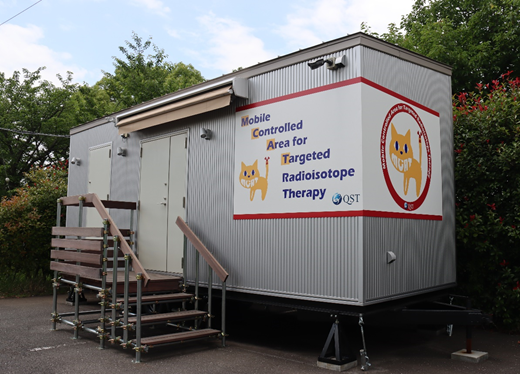The Department of Molecular Imaging & Theranostics (NIRS-MIT) is a cluster of research groups working in such fields as molecular imaging and diagnosis and molecular-targeted therapies.Molecular imaging is concerned with the investigation and visualization of molecular and cellular processes in biological systems, with positron emission tomography (PET) and magnetic resonance imaging (MRI) already utilized clinically in these applications.Recently, "theranostics" the combination of "therapy" and "diagnosis" has also become one of the most important topics in medical science.Our work on theranostics includes the use of PET, MRI, and radioisotopes for basic research, medical engineering research, preclinical research, and clinical applications, primarily in oncology, with aims that include personalized medicine and the study of molecular imaging diagnosis and its clinical applications.
Mobile, Compact, Access-friendly Therapy: “MCAT” is now available!
MCAT is a medical facility for targeted radionuclide cancer therapy. It is based in a trailer that can be easily moved to any hospital. The alpha-emitter 225Ac was approved by the Nuclear Regulation Authority on June 30, 2022, so therapy with alpha-emitting 225Ac-radiotherapeutic agents is now available. We shall soon be conducting clinical trials with MCAT. The ultimate goal is to make cutting-edge cancer therapy accessible to everyone in need.

Research Theme
Preclinical Research on Molecular Imaging and Targeted Radionuclide Therapy (TRT) for Cancer
Our focus is on developing new multifunctional radionuclide agents for cancer imaging and therapy.Many attempts to characterize cancer have involved the identification of particular molecules that are expressed preferentially in cancer,but not in normal organs and tissues. Radiolabeled targeting agents provide an efficient way to deliver radionuclides to a cancer, enabling cancer-specific imaging and therapy.To develop a new molecular imaging agent, a candidate probe (such as an antibody, peptide, or small molecule) is labeled with a radionuclide that emits gamma-rays or positrons to enable imaging, and this is used to evaluate its biodistribution in tumor mouse models.In the case of targeted radionuclide therapy, these probes are labeled with cytotoxic radionuclides (alpha- and beta-ray emitters) and evaluated for their therapeutic efficacy

Applied MRI Research and Diagnostic Imaging
We develop new techniques for MRI and other imaging modalities, and then deploy them in clinical applications in collaboration with specialist researchers.In parallel with this, we also seek evidence for the physiological sources of signals.We also undertake safety assessments and quality control for the techniques in accordance with international guidelines.


Preclinical Research and Development for Functional and Molecular Imaging
The predominant theme of our research is the development of new in-vivo imaging techniques that can recognize disease, evaluate the benefits of therapy, and discover new diagnostic biomarkers for pre-clinical applications.High-field MRI technology allows non-invasive and high-resolution in-vivo observation.We are working to develop advanced anatomical and functional MRI to reveal the functional synchronization between different brain regions; functional contrast agents and nano-probes that can visualize and characterize brain and tumor function, microstructure, and pathologies (including manganese-enhanced MRI, nitroxyl radicals, and theranostics; multimodal imaging; and advanced hardware, acquisition, and informatics that can achieve high precision imaging.Preclinical research into the efficacy of these approaches helps guide the research and development of diagnostic technologies that offer higher levels of precision.This is speeding progress in various fields of medical research.

Clinical Research of PET Molecular Cancer Imaging
Noninvasive PET molecular cancer imaging of drug-target proteins and drug-target processes will provide criteria for selecting individualized therapies and monitoring their efficacy.We are developing imaging agents that will not only allow us to detect cancer earlier,but will also help us to monitor treatment as it happens,providing a better understanding of the therapeutic process.This understanding will be crucial for individualizing cancer therapy.To achieve this, we are using modern structural biology and chemistry to develop novel imaging agents tailored to particular proteins,peptides, amino acids, and other targets.The core concept of NIRS-MIT is to bring together under one roof both basic and clinical-translational research into PET molecular cancer imaging, including pre-clinical studies and phase 1 and phase 2 clinical trials.
Clinical Research and Development of New Targeted Radionuclide Therapies (TRT)
Targeted radionuclide therapy (TRT) aims to improve cancer patient survival and to control the progression of metastatic lesions.TRT has undergone significant development in recent years, including the development of new peptide-targeted therapies and surface-antigen-targeted therapies using monoclonal antibodies.In addition, the use of alpha emitters also provides a new therapeutic option for TRT.Our aim is to work on basic research and technological development as part of a nation-wide TRT development project.
Research Group
- Experimental Nuclear Medicine Goup
- Applied MRI Research Goup
- Diagnostic and Therapeutic Nuclear Medicine Goup
- Functional and Molecular Imaging Goup
